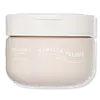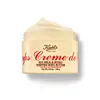What's inside
What's inside
 Key Ingredients
Key Ingredients

 Benefits
Benefits

 Concerns
Concerns

 Ingredients Side-by-side
Ingredients Side-by-side

Water
Skin ConditioningCaprylic/Capric Triglyceride
MaskingOlea Europaea Fruit Oil
MaskingCetyl Alcohol
EmollientGlycerin
HumectantParfum
MaskingSodium Acrylate/Sodium Acryloyldimethyl Taurate Copolymer
Emulsion StabilisingHelianthus Annuus Seed Oil
EmollientPhenoxyethanol
PreservativeGlyceryl Stearate
EmollientPolysorbate 80
EmulsifyingButyrospermum Parkii Butter
Skin ConditioningEthylhexylglycerin
Skin ConditioningTheobroma Cacao Seed Butter
EmollientTetrasodium Glutamate Diacetate
Propylene Glycol
HumectantCereus Grandiflorus Flower Extract
Skin ConditioningArgania Spinosa Kernel Oil
EmollientCocos Nucifera Oil
MaskingCucumis Sativus Seed Oil
EmollientMacadamia Integrifolia Seed Oil
Skin ConditioningPersea Gratissima Oil
Skin ConditioningRosa Moschata Seed Oil
EmollientSimmondsia Chinensis Seed Oil
EmollientVitis Vinifera Seed Oil
EmollientSodium Hyaluronate
HumectantAscorbic Acid
AntioxidantTocopheryl Acetate
AntioxidantCoumarin
PerfumingBenzyl Benzoate
AntimicrobialBenzyl Alcohol
PerfumingBenzyl Cinnamate
PerfumingCI 16035
Cosmetic ColorantCI 15985
Cosmetic ColorantCI 19140
Cosmetic ColorantWater, Caprylic/Capric Triglyceride, Olea Europaea Fruit Oil, Cetyl Alcohol, Glycerin, Parfum, Sodium Acrylate/Sodium Acryloyldimethyl Taurate Copolymer, Helianthus Annuus Seed Oil, Phenoxyethanol, Glyceryl Stearate, Polysorbate 80, Butyrospermum Parkii Butter, Ethylhexylglycerin, Theobroma Cacao Seed Butter, Tetrasodium Glutamate Diacetate, Propylene Glycol, Cereus Grandiflorus Flower Extract, Argania Spinosa Kernel Oil, Cocos Nucifera Oil, Cucumis Sativus Seed Oil, Macadamia Integrifolia Seed Oil, Persea Gratissima Oil, Rosa Moschata Seed Oil, Simmondsia Chinensis Seed Oil, Vitis Vinifera Seed Oil, Sodium Hyaluronate, Ascorbic Acid, Tocopheryl Acetate, Coumarin, Benzyl Benzoate, Benzyl Alcohol, Benzyl Cinnamate, CI 16035, CI 15985, CI 19140
Water
Skin ConditioningGlycerin
HumectantCaprylic/Capric Triglyceride
MaskingNylon-66
Butyrospermum Parkii Butter
Skin ConditioningGlyceryl Stearate
EmollientPEG-7 Glyceryl Cocoate
EmulsifyingPEG-40 Stearate
EmulsifyingSqualane
EmollientMyristyl Myristate
EmollientAmmonium Polyacryloyldimethyl Taurate
Emulsion StabilisingSimmondsia Chinensis Butter
Skin ConditioningSorbitan Tristearate
EmulsifyingParfum
MaskingUndecane
EmollientPhenoxyethanol
PreservativeCetyl Alcohol
EmollientPropylene Glycol
HumectantCaprylyl Glycol
EmollientTridecane
PerfumingTocopherol
AntioxidantSorbic Acid
PreservativeChlorphenesin
AntimicrobialMel
EmollientTrisodium Ethylenediamine Disuccinate
CI 77891
Cosmetic ColorantPentaerythrityl Tetra-Di-T-Butyl Hydroxyhydrocinnamate
AntioxidantSodium Hydroxide
BufferingCoumarin
PerfumingHydrolyzed Soy Protein
HumectantBenzyl Alcohol
PerfumingSorbitol
HumectantHelianthus Annuus Seed Oil
EmollientLimonene
PerfumingCI 40800
Cosmetic ColorantCitric Acid
BufferingWater, Glycerin, Caprylic/Capric Triglyceride, Nylon-66, Butyrospermum Parkii Butter, Glyceryl Stearate, PEG-7 Glyceryl Cocoate, PEG-40 Stearate, Squalane, Myristyl Myristate, Ammonium Polyacryloyldimethyl Taurate, Simmondsia Chinensis Butter, Sorbitan Tristearate, Parfum, Undecane, Phenoxyethanol, Cetyl Alcohol, Propylene Glycol, Caprylyl Glycol, Tridecane, Tocopherol, Sorbic Acid, Chlorphenesin, Mel, Trisodium Ethylenediamine Disuccinate, CI 77891, Pentaerythrityl Tetra-Di-T-Butyl Hydroxyhydrocinnamate, Sodium Hydroxide, Coumarin, Hydrolyzed Soy Protein, Benzyl Alcohol, Sorbitol, Helianthus Annuus Seed Oil, Limonene, CI 40800, Citric Acid
 Reviews
Reviews

Ingredients Explained
These ingredients are found in both products.
Ingredients higher up in an ingredient list are typically present in a larger amount.
Benzyl Alcohol is most commonly used as a preservative. It also has a subtle, sweet smell. Small amounts of Benzyl Alcohol is not irritating and safe to use in skincare products. Most Benzyl Alcohol is derived from fruits such as apricots.
Benzyl Alcohol has both antibacterial and antioxidant properties. These properties help lengthen the shelf life of products. Benzyl Alcohol is a solvent and helps dissolve other ingredients. It can also improve the texture and spreadability.
Alcohol comes in many different forms. Different types of alcohol will have different effects on skin. This ingredient is an astringent alcohol.
Using high concentrations of these alcohols are drying on the skin. They may strip away your skin's natural oils and even damage your skin barrier. Astringent alcohols may also irritate skin.
Other types of astringent alcohols include:
According to the National Rosacea Society based in the US, you should be mindful of products with these alcohols in the top half of ingredients.
Any type of sanitizing product will have high amounts of alcohol to help kill bacteria and viruses.
Learn more about Benzyl AlcoholThis ingredient is also known as shea butter. It is an effective skin hydrator and emollient.
Emollients help soothe and soften your skin. It does this by creating a protective film on your skin. This barrier helps trap moisture and keeps your skin hydrated. Emollients may be effective at treating dry or itchy skin.
Shea butter is rich in antioxidants. Antioxidants help fight free-radicals, or molecules that may harm the body. It is also full of fatty acids including stearic acid and linoleic acid. These acids help replenish the skin and keep skin moisturized.
While Shea Butter has an SPF rating of about 3-4, it is not a sunscreen replacement.
Shea butter may not be fungal acne safe. We recommend speaking with a professional if you have any concerns.
Learn more about Butyrospermum Parkii ButterThis ingredient is an emollient, solvent, and texture enhancer. It is considered a skin-softener by helping the skin prevent moisture loss.
It helps thicken a product's formula and makes it easier to spread by dissolving clumping compounds.
Caprylic Triglyceride is made by combining glycerin with coconut oil, forming a clear liquid.
While there is an assumption Caprylic Triglyceride can clog pores due to it being derived from coconut oil, there is no research supporting this.
Learn more about Caprylic/Capric TriglycerideCetyl Alcohol is a fatty alcohol. Fatty Alcohols are most often used as an emollient or to thicken a product.
Its main roles are:
Though it has "alcohol" in the name, it is not related to denatured alcohol or ethyl alcohol.
The FDA allows products labeled "alcohol-free" to have fatty alcohols.
Learn more about Cetyl AlcoholCoumarins are a group of substances found naturally in plants. There are over 1300 types of coumarins identified. It has a natural vanilla scent.
Coumarin is an identified EU known allergy, meaning it may cause an allergic reaction when applied to the skin.
In many countries, coumarin is banned as a food additive. However, it can be found in soaps, tobacco products, and some alcohol drinks.
Plants use coumarins as a chemical defense. Some plants that have coumarins include lavender, tonka beans, and yellow clovers.
Learn more about CoumarinGlycerin is already naturally found in your skin. It helps moisturize and protect your skin.
A study from 2016 found glycerin to be more effective as a humectant than AHAs and hyaluronic acid.
As a humectant, it helps the skin stay hydrated by pulling moisture to your skin. The low molecular weight of glycerin allows it to pull moisture into the deeper layers of your skin.
Hydrated skin improves your skin barrier; Your skin barrier helps protect against irritants and bacteria.
Glycerin has also been found to have antimicrobial and antiviral properties. Due to these properties, glycerin is often used in wound and burn treatments.
In cosmetics, glycerin is usually derived from plants such as soybean or palm. However, it can also be sourced from animals, such as tallow or animal fat.
This ingredient is organic, colorless, odorless, and non-toxic.
Glycerin is the name for this ingredient in American English. British English uses Glycerol/Glycerine.
Learn more about GlycerinGlyceryl Stearate is a mix of glycerin and stearic acid.
It is used to stabilize the mixing of water and oil ingredients. By preventing these ingredients from separating, it can help elongate shelf life. It can also help thicken the product's texture.
As an emollient, it helps soften skin and supports barrier-replenishing ingredients.
In cosmetics, Glyceryl Stearate is often made from vegetable oils or synthetically produced.
This ingredient may not be fungal-acne safe
Fun fact: The human body also creates Glyceryl Stearate naturally.
Learn more about Glyceryl StearateHelianthus Annuus Seed Oil is the oil derived from the seeds of a Sunflower. Sunflower seed oil is non-fragrant. It is an emollient, meaning it helps to soften the skin.
Sunflower seed oil contains many fatty acids. The fatty acids found in sunflower seeds include (from highest amount to least): linoleic acid, myristic acid, palmitic acid, stearic acid, arachidic acid, oleic acid, and linolenic acid.
These fatty acids help the skin create ceramides. Ceramides play a role in repairing the skin barrier.
Helianthus Annuus Seed Oil helps moisturize the skin. This in turn helps the skin look more rejuvenated and smoother.
Sunflowers are rich in vitamin E.
Historians believe Indigenous cultures of North America domesticated sunflowers before corn. Thus they relied on sunflower oil for a variety of uses. One such use is moisturizing skin and hair.
Sunflower seed oil may not be fungal acne safe. We recommend speaking with a professional if you have any concerns.
Learn more about Helianthus Annuus Seed OilParfum is a catch-all term for an ingredient or more that is used to give a scent to products.
Also called "fragrance", this ingredient can be a blend of hundreds of chemicals or plant oils. This means every product with "fragrance" or "parfum" in the ingredients list is a different mixture.
For instance, Habanolide is a proprietary trade name for a specific aroma chemical. When used as a fragrance ingredient in cosmetics, most aroma chemicals fall under the broad labeling category of “FRAGRANCE” or “PARFUM” according to EU and US regulations.
The term 'parfum' or 'fragrance' is not regulated in many countries. In many cases, it is up to the brand to define this term.
For instance, many brands choose to label themselves as "fragrance-free" because they are not using synthetic fragrances. However, their products may still contain ingredients such as essential oils that are considered a fragrance by INCI standards.
One example is Calendula flower extract. Calendula is an essential oil that still imparts a scent or 'fragrance'.
Depending on the blend, the ingredients in the mixture can cause allergies and sensitivities on the skin. Some ingredients that are known EU allergens include linalool and citronellol.
Parfum can also be used to mask or cover an unpleasant scent.
The bottom line is: not all fragrances/parfum/ingredients are created equally. If you are worried about fragrances, we recommend taking a closer look at an ingredient. And of course, we always recommend speaking with a professional.
Learn more about ParfumPhenoxyethanol is a preservative that has germicide, antimicrobial, and aromatic properties. Studies show that phenoxyethanol can prevent microbial growth. By itself, it has a scent that is similar to that of a rose.
It's often used in formulations along with Caprylyl Glycol to preserve the shelf life of products.
Propylene Glycol is an odorless, colorless liquid. As a humectant, it helps skin retain moisture. It also aids in delivering active ingredients.
Another role of this ingredient is preventing a product from melting or freezing. Propylene glycol also adds antimicrobrial properties to a product, elongating product lifespan.
This ingredient is considered an organic alcohol and commonly added into both cosmetics and foods.
Those with sensitive skin or conditions may develop a rash when using this ingredient.
Learn more about Propylene GlycolWater. It's the most common cosmetic ingredient of all. You'll usually see it at the top of ingredient lists, meaning that it makes up the largest part of the product.
So why is it so popular? Water most often acts as a solvent - this means that it helps dissolve other ingredients into the formulation.
You'll also recognize water as that liquid we all need to stay alive. If you see this, drink a glass of water. Stay hydrated!
Learn more about Water